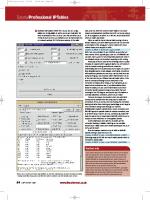Mastering Shiny 9781492047384
1,293 163 8MB
English Pages 523 Year 2021
Preface
What Is Shiny?
Who Should Read This Book?
What Will You Learn?
What Won’t You Learn?
Prerequisites
Conventions Used in This Book
Using Code Examples
O’Reilly Online Learning
How to Contact Us
Acknowledgments
How This Book Was Built
I. Getting Started
1. Your First Shiny App
Introduction
Create App Directory and File
Running and Stopping
Adding UI Controls
Adding Behavior
Reducing Duplication with Reactive Expressions
Summary
Exercises
2. Basic UI
Introduction
Inputs
Common Structure
Free Text
Numeric Inputs
Dates
Limited Choices
File Uploads
Action Buttons
Exercises
Outputs
Text
Tables
Plots
Downloads
Exercises
Summary
3. Basic Reactivity
Introduction
The Server Function
Input
Output
Reactive Programming
Imperative Versus Declarative Programming
Laziness
The Reactive Graph
Reactive Expressions
Execution Order
Exercises
Reactive Expressions
The Motivation
The App
The Reactive Graph
Simplifying the Graph
Why Do We Need Reactive Expressions?
Controlling Timing of Evaluation
Timed Invalidation
On Click
Observers
Summary
4. Case Study: ER Injuries
Introduction
The Data
Exploration
Prototype
Polish Tables
Rate Versus Count
Narrative
Exercises
Summary
II. Shiny in Action
5. Workflow
Development Workflow
Creating the App
Seeing Your Changes
Controlling the View
Debugging
Reading Tracebacks
Tracebacks in Shiny
The Interactive Debugger
Case Study
Debugging Reactivity
Getting Help
Reprex Basics
Making a Reprex
Making a Minimal Reprex
Case Study
Summary
6. Layout, Themes, HTML
Introduction
Single-Page Layouts
Page Functions
Page with Sidebar
Multirow
Exercises
Multipage Layouts
Tabsets
Navlists and Navbars
Bootstrap
Themes
Getting Started
Shiny Themes
Plot Themes
Exercises
Under the Hood
Summary
7. Graphics
Interactivity
Basics
Clicking
Other Point Events
Brushing
Modifying the Plot
Interactivity Limitations
Dynamic Height and Width
Images
Summary
8. User Feedback
Validation
Validating Input
Canceling Execution with req()
req() and Validation
Validate Output
Notifications
Transient Notification
Removing on Completion
Progressive Updates
Progress Bars
Shiny
Waiter
Spinners
Confirming and Undoing
Explicit Confirmation
Undoing an Action
Trash
Summary
9. Uploads and Downloads
Upload
UI
Server
Uploading Data
Download
Basics
Downloading Data
Downloading Reports
Case Study
Exercises
Summary
10. Dynamic UI
Updating Inputs
Simple Uses
Hierarchical Select Boxes
Freezing Reactive Inputs
Circular References
Interrelated Inputs
Exercises
Dynamic Visibility
Conditional UI
Wizard Interface
Exercises
Creating UI with Code
Getting Started
Multiple Controls
Dynamic Filtering
Dialog Boxes
Exercises
Summary
11. Bookmarking
Basic Idea
Updating the URL
Storing Richer State
Bookmarking Challenges
Exercises
Summary
12. Tidy Evaluation
Motivation
Data-Masking
Getting Started
Example: ggplot2
Example: dplyr
User-Supplied Data
Why Not Use Base R?
Tidy-Selection
Indirection
Tidy-Selection and Data-Masking
parse() and eval()
Summary
III. Mastering Reactivity
13. Why Reactivity?
Introduction
Why Do We Need Reactive Programming?
Why Can’t You Use Variables?
What About Functions?
Event-Driven Programming
Reactive Programming
A Brief History of Reactive Programming
Summary
14. The Reactive Graph
Introduction
A Step-by-Step Tour of Reactive Execution
A Session Begins
Execution Begins
Reading a Reactive Expression
Reading an Input
Reactive Expression Completes
Output Completes
The Next Output Executes
Execution Completes, Outputs Flushed
An Input Changes
Invalidating the Inputs
Notifying Dependencies
Removing Relationships
Re-execution
Exercises
Dynamism
The Reactlog Package
Summary
15. Reactive Building Blocks
Reactive Values
Exercises
Reactive Expressions
Errors
on.exit()
Exercises
Observers and Outputs
Isolating Code
isolate()
observeEvent() and eventReactive()
Exercises
Timed Invalidation
Polling
Long-Running Reactives
Timer Accuracy
Exercises
Summary
16. Escaping the Graph
Introduction
What Doesn’t the Reactive Graph Capture?
Case Studies
One Output Modified by Multiple Inputs
Accumulating Inputs
Pausing Animations
Exercises
Antipatterns
Summary
IV. Best Practices
17. General Guidelines
Introduction
Code Organization
Testing
Dependency Management
Source Code Management
Continuous Integration/Deployment
Code Reviews
Summary
18. Functions
File Organization
UI Functions
Other Applications
Functional Programming
UI as Data
Server Functions
Reading Uploaded Data
Internal Functions
Summary
19. Shiny Modules
Motivation
Module Basics
Module UI
Module Server
Updated App
Namespacing
Naming Conventions
Exercises
Inputs and Outputs
Getting Started: UI Input and Server Output
Case Study: Selecting a Numeric Variable
Server Inputs
Modules Inside of Modules
Case Study: Histogram
Multiple Outputs
Exercises
Case Studies
Limited Selection and Other
Wizard
Dynamic UI
Single Object Modules
Summary
20. Packages
Converting an Existing App
Single File
Module Files
A Package
Benefits
Workflow
Sharing
Extra Steps
Deploying Your App-Package
R CMD check
Summary
21. Testing
Testing Functions
Basic Structure
Basic Workflow
Key Expectations
User Interface Functions
Workflow
Code Coverage
Keyboard Shortcuts
Workflow Summary
Testing Reactivity
Modules
Limitations
Testing JavaScript
Basic Operation
Case Study
Testing Visuals
Philosophy
When Should You Write Tests?
Summary
22. Security
Data
Compute Resources
23. Performance
Dining at Restaurant Shiny
Benchmark
Recording
Replay
Analysis
Profiling
The Flame Graph
Profiling R Code
Profiling a Shiny App
Limitations
Improve Performance
Caching
Basics
Caching a Reactive
Caching Plots
Cache Key
Cache Scope
Other Optimizations
Schedule Data Munging
Manage User Expectations
Summary
Index
Recommend Papers

- Author / Uploaded
- Hadley Wickham
File loading please wait...
Citation preview
Mastering Shiny Build Interactive Apps, Reports, and Dashboards Powered by R Hadley Wickham
Mastering Shiny by Hadley Wickham Copyright © 2021 Hadley Wickham. All rights reserved. Printed in the United States of America. Published by O’Reilly Media, Inc., 1005 Gravenstein Highway North, Sebastopol, CA 95472. O’Reilly books may be purchased for educational, business, or sales promotional use. Online editions are also available for most titles (http://oreilly.com). For more information, contact our corporate/institutional sales department: 800-998-9938 or [email protected]. Acquisitions Editor: Jessica Haberman Development Editor: Melissa Potter Production Editor: Christopher Faucher Copyeditor: nSight, Inc. Proofreader: Piper Editorial Consulting, LLC Indexer: Judith McConville Interior Designer: David Futato Cover Designer: Karen Montgomery Illustrator: Kate Dullea May 2021: First Edition Revision History for the First Edition
2020-04-29: First Release See http://oreilly.com/catalog/errata.csp?isbn=9781492047384 for release details. The O’Reilly logo is a registered trademark of O’Reilly Media, Inc. Mastering Shiny, the cover image, and related trade dress are trademarks of O’Reilly Media, Inc. The views expressed in this work are those of the author, and do not represent the publisher’s views. While the publisher and the author have used good faith efforts to ensure that the information and instructions contained in this work are accurate, the publisher and the author disclaim all responsibility for errors or omissions, including without limitation responsibility for damages resulting from the use of or reliance on this work. Use of the information and instructions contained in this work is at your own risk. If any code samples or other technology this work contains or describes is subject to open source licenses or the intellectual property rights of others, it is your responsibility to ensure that your use thereof complies with such licenses and/or rights. Mastering Shiny is available under the Creative Commons AttributionNonCommercial-NoDerivatives 4.0 International License. The author maintains an online version at https://mastering-shiny.org. 978-1-492-04738-4 [LSI]
Preface What Is Shiny? If you’ve never used Shiny before, welcome! Shiny is an R package that allows you to easily create rich, interactive web apps. Shiny allows you to take your work in R and expose it via a web browser so that anyone can use it. Shiny makes you look awesome by making it easy to produce polished web apps with a minimum amount of pain. In the past, creating web apps was hard for most R users because: You need a deep knowledge of web technologies like HTML, CSS, and JavaScript. Making complex interactive apps requires careful analysis of interaction flows to make sure that when an input changes, only the related outputs are updated. Shiny makes it significantly easier for the R programmer to create web apps by: Providing a carefully curated set of user interface (UI for short) functions that generate the HTML, CSS, and JavaScript needed for common tasks. This means that you don’t need to know the details of HTML/CSS/JavaScript until you want to go beyond the basics that Shiny provides for you. Introducing a new style of programming called reactive programming, which automatically tracks the dependencies of pieces of code. This means that whenever an input changes, Shiny can automatically figure out how to do the smallest amount of work to update all the related outputs. People use Shiny to:
Create dashboards that track important high-level performance indicators while facilitating drill-down into metrics that need more investigation. Replace hundreds of pages of PDFs with interactive apps that allow the user to jump to the exact slice of the results that they care about. Communicate complex models to a nontechnical audience with informative visualizations and interactive sensitivity analysis. Provide self-service data analysis for common workflows, replacing email requests with a Shiny app that allows people to upload their own data and perform standard analyses. You can make sophisticated R analyses available to users with no programming skills. Create interactive demos for teaching statistics and data science concepts that allow learners to tweak inputs and observe the downstream effects of those changes in an analysis. In short, Shiny gives you the ability to pass on some of your R superpowers to anyone who can use the web.
Who Should Read This Book? This book is aimed at two main audiences: R users who are interested in learning about Shiny in order to turn their analyses into interactive web apps. To get the most out of this book, you should be comfortable using R to do data analysis and should have written at least a few functions. Existing Shiny users who want to improve their knowledge of the theory underlying Shiny in order to write higher-quality apps faster and more easily. You should find this book particularly helpful if
your apps are starting to get bigger and you’re starting to have problems managing the complexity.
What Will You Learn? The book is divided into four parts: 1. In Part I, you’ll learn the basics of Shiny so you can get up and running as quickly as possible. You’ll learn about the basics of app structure, useful UI components, and the foundations of reactive programming. 2. Part II builds on the basics to help you solve common problems, including giving feedback to the user, uploading and downloading data, generating UI with code, reducing code duplication, and using Shiny to program the tidyverse. 3. In Part III, you’ll go deep into the theory and practice of reactive programming, the programming paradigm that underlies Shiny. If you’re an existing Shiny user, you’ll get the most value out of this chapter as it will give you a solid theoretical underpinning that will allow you to create new tools specifically tailored for your problems. 4. Finally, in Part IV we’ll finish up with a survey of useful techniques for making your Shiny apps work well in production. You’ll learn how to decompose complex apps into functions and modules, how to use packages to organize your code, how to test your code to ensure it’s correct, and how to measure and improve performance.
What Won’t You Learn? The focus of this book is making effective Shiny apps and understanding the underlying theory of reactivity. I’ll do my best to showcase best
practices for data science, R programming, and software engineering, but you’ll need other references to master these important skills. If you enjoy my writing in this book, you might enjoy my other books on these topics: R for Data Science, Advanced R, and R Packages. There are also a number of important topics specific to Shiny that I don’t cover: This book only covers the built-in user interface toolkit. This doesn’t provide the sexiest possible design, but it’s simple to learn and gets you a long way. If you have additional needs (or just get bored with the defaults), there are a number of other packages that provide alternative frontends. See “Bootstrap” for more details. Deployment of Shiny apps. Putting Shiny “into production” is outside the scope of this book because it hugely varies from company to company, and much of it is unrelated to R (the majority of challenges tend to be cultural or organizational, not technical). If you’re new to Shiny in production, I recommend starting with Joe Cheng’s 2019 rstudio::conf keynote. That will give you the lay of the land, discussing broadly what putting Shiny into production entails and how to overcome some of the challenges that you’re likely to face. Once you’ve done that, see the RStudio Connect website to learn about RStudio’s product for deploying apps within your company, and the Shiny website for other common deployment scenarios.
Prerequisites Before we continue, make sure you have all the software you need for this book: R If you don’t have R installed already, you may be reading the wrong book; I assume a basic familiarity with R throughout this book. If you’d
like to learn how to use R, I’d recommend my R for Data Science, which is designed to get you up and running with R with a minimum of fuss. RStudio RStudio is a free and open source integrated development environment (IDE) for R. While you can write and use Shiny apps with any R environment (including R GUI and ESS), RStudio has some nice features specifically for authoring, debugging, and deploying Shiny apps. We recommend downloading RStudio Desktop and giving it a try, but it’s not required to be successful with Shiny or with this book. R packages This book uses a bunch of R packages. You can install them all at once by running: install.packages(c( "gapminder", "ggforce", "gh", "globals", "openintro", "profvis", "RSQLite", "shiny", "shinycssloaders", "shinyFeedback", "shinythemes", "testthat", "thematic", "tidyverse", "vroom", "waiter", "xml2", "zeallot" ))
If you’ve downloaded Shiny in the past, make sure that you have at least version 1.6.0.
Conventions Used in This Book The following typographical conventions are used in this book: Italic
Indicates new terms, URLs, email addresses, filenames, and file extensions. Constant width Used for program listings, as well as within paragraphs to refer to program elements such as variable or function names, databases, data types, environment variables, statements, and keywords. Constant width bold Shows commands or other text that should be typed literally by the user. Constant width italic Shows text that should be replaced with user-supplied values or by values determined by context. TIP This element signifies a tip or suggestion.
NOTE This element signifies a general note.
Using Code Examples Supplemental material (code examples, exercises, etc.) is available for download at https://mastering-shiny.org. The code samples in this book are licensed under the MIT License. If you have a technical question or a problem using the code examples, please send email to [email protected].
This book is here to help you get your job done. In general, if example code is offered with this book, you may use it in your programs and documentation. You do not need to contact us for permission unless you’re reproducing a significant portion of the code. For example, writing a program that uses several chunks of code from this book does not require permission. Selling or distributing examples from O’Reilly books does require permission. Answering a question by citing this book and quoting example code does not require permission. Incorporating a significant amount of example code from this book into your product’s documentation does require permission. We appreciate, but generally do not require, attribution. An attribution usually includes the title, author, publisher, and ISBN. For example: “Mastering Shiny by Hadley Wickham (O’Reilly). Copyright 2021 Hadley Wickham, 978-1-492-04738-4.” If you feel your use of code examples falls outside fair use or the permission given above, feel free to contact us at [email protected].
O’Reilly Online Learning NOTE For more than 40 years, O’Reilly Media has provided technology and business training, knowledge, and insight to help companies succeed.
Our unique network of experts and innovators share their knowledge and expertise through books, articles, and our online learning platform. O’Reilly’s online learning platform gives you on-demand access to live training courses, in-depth learning paths, interactive coding environments, and a vast collection of text and video from O’Reilly and 200+ other publishers. For more information, visit http://oreilly.com.
How to Contact Us Please address comments and questions concerning this book to the publisher: O’Reilly Media, Inc. 1005 Gravenstein Highway North Sebastopol, CA 95472 800-998-9938 (in the United States or Canada) 707-829-0515 (international or local) 707-829-0104 (fax) We have a web page for this book, where we list errata, examples, and any additional information. You can access this page at https://oreil.ly/mastering-shiny. Email [email protected] to comment or ask technical questions about this book. For news and information about our books and courses, visit http://oreilly.com. Find us on Facebook: http://facebook.com/oreilly Follow us on Twitter: http://twitter.com/oreillymedia Watch us on YouTube: http://youtube.com/oreillymedia
Acknowledgments This book was written in the open, and chapters were advertised on Twitter when complete. It is truly a community effort: many people read drafts, fixed typos, suggested improvements, and contributed content. Without
those contributors, the book wouldn’t be nearly as good as it is, and I’m deeply grateful for their help. A big thank-you to all 83 people who contributed specific improvements via GitHub pull requests (in alphabetical order by username): Adam Pearce (@1wheel), Adi Sarid (@adisarid), Alexandros Melemenidis (@alex-mffm), Anton Klåvus (@antonvsdata), Betsy Rosalen (@betsyrosalen), Michael Beigelmacher (@brooklynbagel), Bryan Smith (@BSCowboy), c1au6io_hh (@c1au6i0), @canovasjm, Chris Beeley (@ChrisBeeley), @chsafouane, Chuliang Xiao (@ChuliangXiao), Conor Neilson (@condwanaland), @d-edison, Dean Attali (@daattali), DanielDavid521 (@Danieldavid521), David Granjon (@DivadNojnarg), Eduardo Vásquez (@edovtp), Emil Hvitfeldt (@EmilHvitfeldt), Emilio (@emilopezcano), Emily Riederer (@emilyriederer), Eric Simms (@esimms999), Federico Marini (@federicomarini), Frederik Kok Hansen (@fkoh111), Frans van Dunné (@FvD), Giorgio Comai (@giocomai), Hedley (@heds1), Henning (@henningsway), Hlynur (@hlynurhallgrims), @hsm207, @jacobxk, James Pooley (@jamespooley), Joe Cheng (@jcheng5), Julien Colomb (@jcolomb), Juan C. Rodriguez (@jcrodriguez1989), Jennifer (Jenny) Bryan (@jennybc), Jim Hester (@jimhester), Joachim Gassen (@joachimgassen), Jon Calder (@jonmcalder), Jonathan Carroll (@jonocarroll), Julian Stanley (@julianstanley), @jyuu, @kaanpekel, Karandeep Singh (@kdpsingh), Robert Kirk DeLisle (@KirkDCO), Elaine (@loomalaine), Malcolm Barrett (@malcolmbarrett), Marly Gotti (@marlycormar), Matthew Wilson (@MattW-Geospatial), Matthew T. Warkentin (@mattwarkentin), Mauro Lepore (@maurolepore), Maximilian Rohde (@maxdrohde), Matthew Berginski (@mbergins), Michael Dewar (@michael-dewar), Mine Cetinkaya-Rundel (@mine-cetinkaya-rundel), Maria Paula Caldas (@mpaulacaldas), nthobservation (@nthobservation), Pietro Monticone (@pitmonticone), psychometrician (@psychometrician), Ram Thapa (@raamthapa), Janko Thyson (@rappster), Rebecca Janis (@rbjanis), Tom Palmer (@remlapmot), Russ Hyde (@russHyde), Barret Schloerke (@schloerke), Scott (@scottyd22), Matthew Sedaghatfar (@sedaghatfar), Shixiang Wang (@ShixiangWang), Praer (Suthira Owlarn) (@sowla), Sébastien Rochette (@statnmap), @stevensbr, André Calero
Valdez (@Sumidu), Tanner Stauss (@tmstauss), Tony Fujs (@tonyfujs), Stefan Moog (@trekonom), Jeff Allen (@trestletech), Trey Gilliland (@treygilliland), Albrecht (@Tungurahua), Valeri Voev (@ValeriVoev), Vickus (@Vickusr), William Doane (@WilDoane), 黄湘云 (@XiangyunHuang), and gXcloud (@xwydq).
How This Book Was Built This book was written in RStudio using bookdown. The book’s website is hosted with netlify and is automatically updated after every commit by GitHub Actions. The complete source is available from GitHub. This version of the book was built with R version 4.0.3 (2020-10-10) and the following packages:
Package
Version
Source
gapminder
0.3.0
standard (@0.3.0)
ggforce
0.3.2
standard (@0.3.2)
gh
1.2.0
standard (@1.2.0)
globals
0.14.0
standard (@0.14.0)
openintro
2.0.0
standard (@2.0.0)
profvis
0.3.7.9000
GitHub (rstudio/profvis@ca1b272)
RSQLite
2.2.3
standard (@2.2.3)
shiny
1.6.0
standard (@1.6.0)
shinycssloaders
1.0.0
standard (@1.0.0)
shinyFeedback
0.3.0
standard (@0.3.0)
shinythemes
1.2.0
standard (@1.2.0)
testthat
3.0.2.9000
GitHub (r-lib/testthat@4793514)
thematic
0.1.1
GitHub (rstudio/thematic@d78d24a)
tidyverse
1.3.0
standard (@1.3.0)
vroom
1.3.2
standard (@1.3.2)
waiter
0.2.0
standard (@0.2.0)
xml2
1.3.2
standard (@1.3.2)
zeallot
0.1.0
standard (@0.1.0)
Part I. Getting Started The goal of the next four chapters is to get you writing Shiny apps as quickly as possible. In Chapter 1, I’ll start small, but complete, showing you all the major pieces of an app and how they fit together. Then in Chapters 2 and 3 you’ll start to get into the details of the two major parts of a Shiny app: the frontend (what the user sees in the browser) and the backend (the code that makes it all work). We’ll finish up in Chapter 4 with a case study to help cement the concepts you’ve learned so far.
Chapter 1. Your First Shiny App Introduction In this chapter, we’ll create a simple Shiny app. I’ll start by showing you the minimum boilerplate needed for a Shiny app, and then you’ll learn how to start and stop it. Next you’ll learn the two key components of every Shiny app: the UI (short for user interface), which defines how your app looks, and the server function, which defines how your app works. Shiny uses reactive programming to automatically update outputs when inputs change, so we’ll finish off the chapter by learning the third important component of Shiny apps: reactive expressions. If you haven’t already installed Shiny, install it now with: install.packages("shiny")
If you’ve already installed Shiny, use packageVersion("shiny") to check that you have version 1.5.0 or greater. Then load in your current R session: library(shiny)
Create App Directory and File There are several ways to create a Shiny app. The simplest is to create a new directory for your app and put a single file called app.R in it. This app.R file will be used to tell Shiny both how your app should look and how it should behave. Try it out by creating a new directory and adding an app.R file that looks like this:
library(shiny) ui
![Mastering Shiny: Build Interactive Apps, Reports, and Dashboards Powered by R [1 ed.]
1492047384, 9781492047384](https://ebin.pub/img/200x200/mastering-shiny-build-interactive-apps-reports-and-dashboards-powered-by-r-1nbsped-1492047384-9781492047384.jpg)








